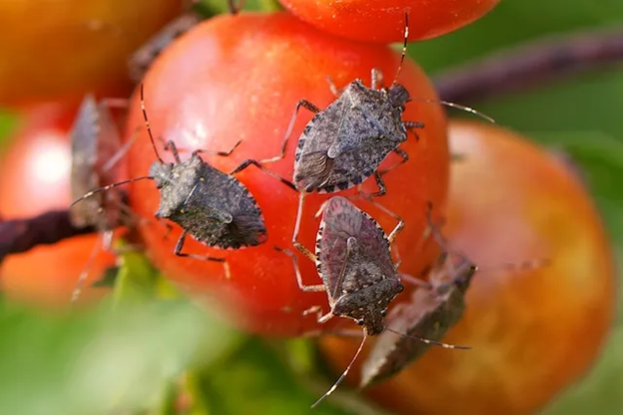
Appearance
Brown Marmorated Stink Bug’s (Halyomorpha halys) are brown with darker brown speckles on top and a pale underside. They are medium-sized insects with a head much smaller than the thorax. The shield shaped thorax is 12-17 mm long. Halyomorpha halys can resemble other stink bugs, like the Minnesota native species Euschistus servus, but the distinguishing feature of the Brown Marmorated Stink Bug are the brown and white alternating stripes on the antenna and along the edge of their thorax.
What does it eat?
Eating is minimal in the winter, but in warmer temperatures they can be a pest to crops like corn, soybeans, cotton, and seed, nut, and fruit trees. They are quite polyphagous and will eat anything from ornamental plants, crops, and trees. They have been found to eat roughly 300 species of plants.
Where and when do you find them?
Native to East Asia, they have become an invasive species in the United States. Now, Brown Marmorated Stink Bugs are commonly found in Minnesota, you may have seen them in your house during the winter because they like warm places to overwinter. Having two life cycles a year, they can be seen from May-Nov. Females lay their eggs throughout the summer (May-Aug) and the nymphs emerge 4-5 days later.
Importance to Minnesota
The Brown Marmorated Stink Bug was first identified in Minnesota in 2010. While being a crop pest is not to be celebrated, a journal article published in 2013 found that the wounds on trees left by the stink bugs became a feeding sight for native wasps and ants. This dynamic creates a new opportunistic food source for the native species and may restructure ecological processes in the areas the Brown Marmorated Stink Bug invade. If you’d like to read the study it can be found here: Invasive Stink Bug Wounds Trees, Liberates Sugars, and Facilitates Native Hymenoptera
Fun fact
Stink Bugs get their name from the odor they admit from being squished. The odor is quite pungent and has an earthy smell, most often described as smelling like cilantro.
For More Information
Author
- Ellen Reed
Photo Credit
- Photo 1: Jeff Hahn Photo
- Photo 2: University of Massachusetts Amherst


